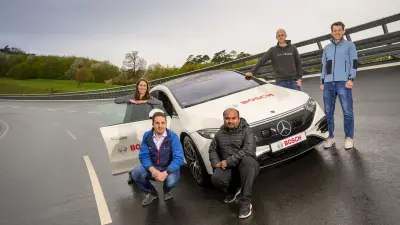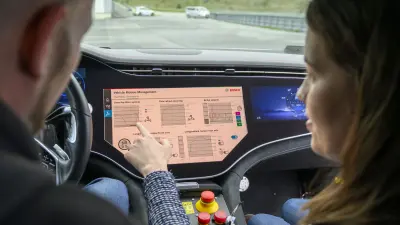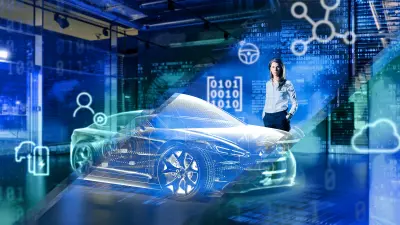Ahead of the curve
Software boom in the mobility sector
The road is wet with rain as Ralf Manemann steps on the gas. He accelerates his 2.8-ton electric car to a speed of 100 kilometers per hour. “We’re going to the right,” he warns his passengers — and then suddenly yanks his steering wheel. All the occupants slide to the edge of their seats, pressing against their tightened seatbelts. Now the rear end should break free, the vehicle skid or drift, the tires squeal. Or that’s what people think who only know such maneuvers from the movies. But the test vehicle equipped with special Bosch technology holds true to its course and rounds a long bend. Manemann stops the car, looks at the diagram in the vehicle display, and is pleased. “It needs a little fine-tuning, but we’re already at 80 percent,” says the engineer at the end of his run on the Bosch test track in Boxberg, Germany.
The steering and brakes worked in almost perfect unison, thanks to new software for Vehicle Motion Management, which controls all the vehicle’s movements. “The wheels should have had a steering angle of 8 degrees when turning the steering wheel,” explains the systems application expert from Automotive Steering. “But the software limited the wheel’s steering angle and allowed for only 2 degrees — as much as was still safe under these conditions.” This is possible because this car’s brake pedal and steering wheel are no longer mechanically connected to the wheels. Everything works electronically and via software.
Manemann and design engineer Kerstin Heuß from Chassis Systems Control discuss a slight jolt at the beginning of the test run. The steering system briefly overcompensated, depicted in the diagram as a large spike. “This still needs to become more fluid,” is Heuß’s analysis. “But then again, these are just our first test drives without snow and ice.” After just four months and 6,000 kilometers of testing, the team has already come a long way.
One for all
About 140 experts from four divisions are working on the Vehicle Motion Management project to create a paradigm shift for Bosch, and the entire automotive industry. “These days, software in vehicles is spread out across many different systems and control units,” says project center head Niccolo Hägele. Steering, ESP® systems, electric motors — each component has its own control unit with proprietary software.

Today, this close connection is dissolving, partly because manufacturers want it that way. “We’re developing software that can control the vehicle in all three dimensions,” says Hägele — and which combines the functions of the brake, steering, drive, and chassis control systems independent of the hardware. This will enable new functions and regular software updates, as is already standard in vehicle infotainment systems. The separation of hardware and software is a significant trend in the automotive industry. It makes it possible to offer application-specific software to vehicle manufacturers as a stand-alone product, even independently of the hardware.

But it’s not just new market trends that drive the project team. Rather, it’s the prospect of fascinating new functions. Design engineer Kerstin Heuß is convinced that the new software can create added value in every driving situation. “During the maneuver earlier, we would surely have had the situation under control using just the brakes,” she says. “But together with the steering, we can do it way more smoothly.”
Because the electric motor is also tied into the system, the wheel brakes and motor brakes can work together. “The electric motor brake is particularly efficient and comfortable,” says Harald Paulhart, software developer at Powertrain Solutions. In addition, electric energy is recovered and then stored in the battery. Combining all the systems should ensure greater safety, more enjoyment while driving, and more sustainability, for example, due to the brakes being used and wearing less.
The vehicle was in the winter test facility in Sweden for weeks, and customers could test it out. “Lots of the customers said, ‘I never thought I could drive so well’,” remembers Heuß. “But it wasn’t them — it was our software,” she adds with a grin. “The car convinced our customers that we are the right partner for a centralized vehicle architecture,” says Manoj Nagarajan from the customer team for a premium vehicle manufacturer.
New structure
That Bosch experts from four divisions are working on the project together is a prime example of why Bosch Mobility is currently restructuring itself for the future. As of 2024, among other changes, Chassis Systems Control and Automotive Steering are merging to form the Vehicle Motion division.
“Now, what belongs together is coming together,” says Heuß. Her project team is already working in a similar structure. The first thing that had to be done was to find a common language. They now no longer see themselves as experts on brakes or steering, but rather on both. “Joint work on the vehicle is what will ultimately bring us together.”, agrees Ralf Manemann before he heads off to his next test drive.


